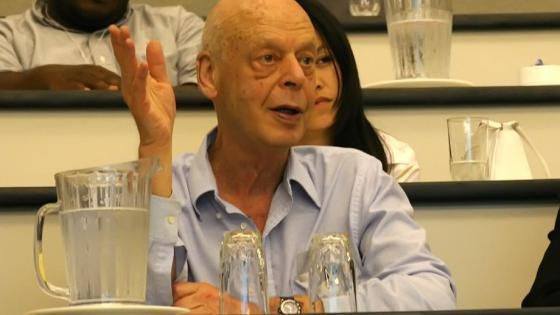When William Baumol passed away in May 2017, he left behind an intellectual legacy that is remarkable for its volume and longevity (he was still writing original research into his 90s!), its scope (ranging from the demand for money in macroeconomics to contestability theory in microeconomics), the practical importance of some of the theories he developed (especially in regulation and public utility pricing), and its enduring value. In particular, I venture to predict that economists (and others) will be talking and thinking about ‘Baumol’s disease’ for generations to come.
In addition, I think it is fair to place Will Baumol among the small but astounding cohort of innovative thinkers, born around 1920, who mathematised economics once and for all in the 1950s.1 Names like Paul Samuelson (born in 1915), Kenneth Arrow (1921), Robert Solow (1924) and Gerard Debreu (1921) spring to mind, though there were others. Baumol (born in 1922) was part of that group.
Unbalanced growth and Baumol’s disease
Will Baumol both started a new sub-discipline (the economics of the arts) and introduced a thoroughly original and important idea in the 1960s: the cost disease of the personally delivered services, now often called Baumol’s disease.
He was initially thinking about the performing arts (Baumol and Bowen 1966) and cost problems in municipal services (Baumol 1967) when he came up with the general idea of ‘unbalanced growth’ – the notion that activities and sectors with relatively slow (or zero) productivity growth were destined to one of two fates. Their ever-rising relative prices would force them either to wither away (like domestic household servants, who were once ubiquitous but are now affordable only by the wealthy) or to grow increasingly costly (like education and healthcare).
Baumol described this discovery in a 2001 interview (Krueger 2001): “One night, it was 4:00 in the morning, I suddenly woke up and said I know why those costs are going up! I got up, wrote down a few notes, and went to sleep again. That’s literally how it happened.”
It did not take long for Baumol and others to realise that the same basic insight extended far beyond symphony orchestras and police departments to an astonishingly wide array of activities.
Baumol’s prize-winning book, Productivity and American Leadership: The Long View (Baumol et al. 1989), showed that the cost disease helped to explain long-term trends and cross-national regularities in broad sectors of national economies. It also introduced the celebrated ‘convergence hypothesis’ to explain why some poor nations flourish while others do not.
The good news is that within the subset of nations that have the proper institutions (including well-functioning markets and sensible government policies), there is a strong tendency for comparatively poor nations to close the income gap with rich ones because it is far easier to imitate than to innovate.
The bad news, however, is that not all nations belong to what Baumol et al. labelled ‘the convergence club’. Countries without an adequate rule of law, without protection for intellectual property, without well-functioning markets and/or with a dearth of entrepreneurs will find it difficult or impossible to ‘follow the leaders’ in this way.
Contestability theory and regulation
Along with co-authors Elizabeth Bailey, John Panzar and Robert Willig, Baumol developed contestability theory as an alternative to the standard theory of competition that has been the bread-and-butter of microeconomics since Adam Smith (see, especially, Baumol et al. 1982). As such, it was and remains controversial.
Contestability theory is built around multiproduct firms and their associated economies (or diseconomies) of scale and scope.2 Equilibrium with multiproduct firms under ‘perfect contestability’ is similar to that with single-product firms under perfect competition: incumbent firms set prices equal to marginal costs, minimise industry-wide costs, and earn zero rents.
But perfect contestability requires, in addition, the assumption of costlessly reversible entry and exit – an idealised situation, of course, analogous to atomistic competition. Notably, perfectly contestable markets display all the aforementioned efficiency properties regardless of whether the industry is monopolised, concentrated or unconcentrated.
Ironically, contestability theory may have had more influence in the practical world of regulation and antitrust than on how graduate microtheory is taught in universities. The key insight for regulators is that sunk costs, not economies of scale, constitute the entry barrier that confers monopoly power. The corresponding policy prescription is to favour measures that make ‘hit-and-run’ entry easier; that redirects attention from market share to the degree of contestability in an industry.
For example, Bailey and Baumol (1984) argued for using the theory to replace rate‑of‑return regulation, and shortly thereafter the Interstate Commerce Commission used this analysis in revising railroad regulations (Willig and Baumol 1987). The idea of contestability also underpinned the revision of the US Merger Guidelines in 1992. Today, an analysis of market structure and competition in any industry must account for sunk costs that may inhibit entry.
Ramsey pricing – or ‘Baumol-Bradford’ pricing
Contestability theory had its roots in Baumol’s earlier work with David Bradford on ‘Ramsey prices’, or what came to be called for a time Baumol‑Bradford prices.3 In what seems obvious now, but was by no means a commonplace then, Baumol and Bradford (1970) posed and answered a question with profound implications for the theory and practice of economic regulation: how do you characterise welfare-optimal departures from marginal cost pricing when, for example, there is a constraint that the prices must generate revenues sufficient to cover the firm’s costs? The relevance to public utility regulation, for example, where increasing returns to scale and natural monopoly are common, is obvious.
In the simplest case where the cross‑elasticities of demand among the firm’s products are all zero, Baumol and Bradford showed that the percentage deviations from marginal costs are inversely proportional to the price elasticities of demand for the firm’s goods. This inverse elasticity rule, which crops up in many other contexts (for example, optimal taxation) says that, to minimise welfare loss, the most inelastic demanders should bear the brunt of making up the losses that would result from pricing at marginal costs.
As Baumol (1968) explained: “If it is necessary in order to meet a revenue requirement to vary prices from marginal costs, the least distortion will be caused if the largest price changes fall on those items whose demand… will not change markedly in response to a departure from marginal cost pricing.”
Baumol recognised early on that the implications were enormous. As he and Bradford noted, the conclusion that the public interest requires regulated prices to be sensitive to conditions of demand as well as to conditions of cost means, among other things, that no regulatory system based solely on costs, no matter how sophisticated, can fully serve the public interest. Here is how he delightfully described his discovery that Pareto-optimal Ramsey prices would (under reasonable assumptions) be sustainable:
“My wife and I were attending a fundraising performance at one of New York’s experimental theaters, and we were waiting in line to get in, surrounded by persons in bizarre dress and make‑up, when, according to my wife, my face took on a rather distracted look. I told her that a theorem which hardly seemed plausible to me had come to me from nowhere, along with what seemed to me to be its entire proof. Indeed, it transpired that the rigorous proof that emerged eventually did follow the outline that came to me suddenly in that theater lobby, but it took weeks of hard labor by (a skeptical) Willig, Bailey (and myself) before it could be put into satisfactory form.” (Baumol 1986).
Inventory theory and the transactions demand for money
The oldest of Baumol’s landmark contributions, dating back to 1952, is probably what has long been called the Baumol-Tobin theory of money demand. James Tobin’s richly deserved Nobel Prize in 1981 was awarded partly for this idea, although Baumol (1952a) had published it four years earlier.
Baumol, who had been deeply immersed in various microeconomic applications of the emerging discipline of operations analysis,4 offered a profoundly useful piece of ‘intellectual arbitrage’ to monetary theory. Cash can be thought of as an inventory of the medium of exchange, held to perform transactions. But cash is costly both to hold (due to the forgone interest) and to obtain (via asset sales or trips to the bank).
By applying the optimal lot size result from inventory theory to this problem, Baumol (1952) showed that (a) the cost-minimising transactions strategy is to demand cash in proportion to the square root of the value of transactions (whereas the quantity theory had suggested proportionality), and (b) a pure transactions-based approach nonetheless implies that the demand for money is interest-elastic.
The latter solved a contemporary intellectual puzzle. Most economists then viewed money as one among many assets in a portfolio. Unfortunately, money was a dominated asset because short-term Treasury bills were riskless but paid interest (whereas money did not at the time). So the asset-demand for money should be zero! This is why so many economists flocked to the Baumol-Tobin transactions demand approach instead.
Final remarks
The preceding is merely a medley of William Baumol’s greatest hits. It leaves out, among other things, the sales maximization hypothesis (Baumol 1958), his original (at the time) contributions to the welfare-theoretic analysis of externalities (Baumol 1952b and Baumol and Oates 1975), the analysis of travel demand (Baumol and Quandt 1966), his creative application of familiar micro-theoretic tools to the elusive fourth factor of production, entrepreneurship,5 and his sceptical minority view on the gains from international trade (Gomory and Baumol 2000).
Baumol’s amazing scholarly career spanned nearly 70 years. But he produced more than enough for two lifetimes.6
References
Bailey, E E and W J Baumol, (1984), “Deregulation and the Theory of Contestable Markets”, Yale Journal of Regulation 1: 111‑32.
Baumol, W J (1952a), “The Transactions Demand for Cash: An Inventory Theoretic Approach”, Quarterly Journal of Economics 66: 545‑56.
Baumol, W J (1952b), Welfare Economics and the Theory of the State, Harvard University Press.
Baumol, W J (1958), “On the Theory of Oligopoly”, Economica 25: 187‑98.
Baumol, W J (1967), “Macroeconomics of Unbalanced Growth: The Anatomy of Urban Crisis”, American Economic Review 57: 415‑26.
Baumol, W J (1968a), “Reasonable Rules for Rate Regulation: Plausible Policies for an Imperfect World”, in Prices: Issues in Theory, Practice and Public Policy edited by A Phillips and OE Williamson, University of Pennsylvania Press.
Baumol, W J (1968b), “Entrepreneurship in Economic Theory”, American Economic Review 58(2): 64-71.
Baumol, W J (1986), Microtheory: Applications and Origins, Wheatsheaf Books.
Baumol, W J (2002), The Free-Market Innovation Machine, Princeton University Press.
Baumol, W J, S A Batey Blackman and E N Wolff (1989), Productivity and American Leadership: The Long View, MIT Press.
Baumol, W J and William G Bowen, (1966), Performing Arts: The Economic Dilemma, MIT Press.
Baumol, W J and D F Bradford, (1970), “Optimal Departures from Marginal Cost Pricing”, American Economic Review 60: 265‑83.
Baumol, W J and W Oates (1975), The Theory of Environmental Policy, Prentice-Hall.
Baumol, W J, J C Panzar and R D Willig (1982), Contestable Markets and the Theory of Industry Structure, Harcourt Brace Jovanovich.
Baumol, W J and R Quandt (1966), “The Demand for Abstract Transport Modes: Theory and Measurement”, Journal of Regional Science.
Gomory, R E and W J Baumol (2000), Global Trade and Conflicting National Interests, MIT Press.
Krueger, A B (2001), “An Interview with William J Baumol”, Journal of Economic Perspectives 15(3): 218.
Willig, R D and W J Baumol, (1987), “Using Competition as a Guide”, Regulation 1: 28-35.
Endnotes
[1] There were certainly precursors. Mathematics had appeared in economics before. But this time it moved from the exception to the rule.
[2] I have a personal recollection of Baumol challenging me once to think of even one single-product firm. Basically, there are none. So the ‘theory of the multi-product firm’ should be synonymous with ‘the theory of the firm’.
[3] It was Baumol and Bradford who mounted the successful campaign to get “Baumol-Bradford prices” renamed “Ramsey prices.”
[4] See, for example, his 1961 classic book, Economic Theory and Operations Analysis, which over several editions taught the subject – and its relevance to economics – to generations of graduate students.
[5] Beginning with his seminal article (Baumol 1968b) and culminating with his widely acclaimed 2002 book, with much scholarly work in between.
[6] Thanks go to Bobby Willig and Cliff Winston for useful suggestions on this account of Will Baumol’s scholarly career.




